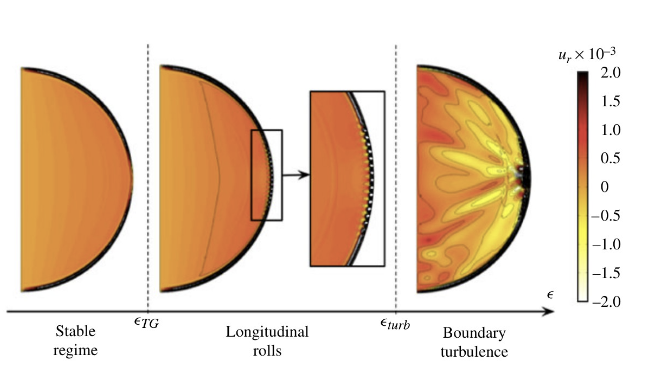Supervisor :
David Cébron
Contact :
david.cebron@univ-grenoble-alpes.fr
Lab :
ISTerre Grenoble
Date :
whenever in the Spring of 2022
Key Words :
numerics; boundary turbulence, planetary core
Context :
In the frame of the ERC project THEIA, we aim at revisiting the boundary coupling between a planetary liquid core (e.g. the one of the Earth or the Moon) and the surrounding planetary mantle. Indeed, geodetic observations constrain this coupling to values which are difficult to reconcile with our current flow dynamics models. In particular, two ingredients are quite badly known: the boundary turbulence and the topographic effects on the flow and on the boundary stress in such planetary cores. Before combining these two key ingredients, which is our long-term goal, we first aim at caracterizing each of them separately in the relevant geometry, when the flow is dominated by rotation.
Project :
In this internship, we will consider the current lunar liquid core, where we may expect no leading order buoyancy and magnetic effects on the boundary layer. Using the in-house spectral code XSHELLS developed by N. Schaeffer, we will simulate Ekman layer instabilities in a rotating sphere, in order to trigger a sustained boundary layer turbulence. Beyond our interest on the instability onset, the turbulent stress will be compared to the laminar one (which is known theoretically), to recent plane layer simulations (Buffett 2021), and to a turbulent model developed for plane Ekman layer at LEGI, by Sous & Sommeria (2013). While we do not expect to reach the highly turbulent regime where this latter model is expected to be valid, we aim at bridging the gap between the well known laminar models and this asymptotic regime.
 Ekman layer, which is laminar (left), and then destabilized into longitudinal rollls (center),
ending in turbulence (right) in a rotating sphere in libration (Sauret et al., JFM 2013)
Ekman layer, which is laminar (left), and then destabilized into longitudinal rollls (center),
ending in turbulence (right) in a rotating sphere in libration (Sauret et al., JFM 2013)